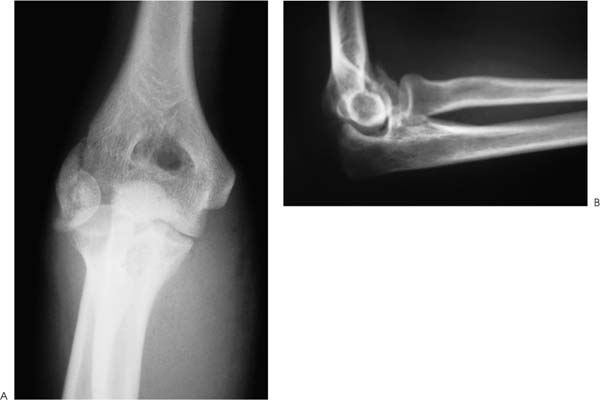Case 34 A 26-year-old woman presents to the office 2 hours after she trips over a water hose and falls forward onto her hands with her elbows in slight flexion. She complains of pain, swelling, and crepitation in the affected elbow. Range of motion of the elbow demonstrates a 30 degree extension lag and flexion to 90 degrees. Forearm rotation causes moderate to severe pain and crepitation. Stability testing is difficult secondary to pain. She is neurovascularly intact. Figure 34–1. Anteroposterior (AP) and lateral (B) radiographs of the elbow. 1. Elbow dislocation 2. Distal humerus fracture 3. Capitellum fracture 4. Radial head fracture • Ectopic bone formation occurs commonly after displaced elbow fractures, and perioperative nonsteroidal antiinflammatory prophylaxis should be seriously considered. Despite the small fracture fragment, extensive dissection is generally required to reduce and stabilize these fractures, making postoperative ectopic bone formation more likely. • Anatomic reduction and excellent fracture fixation is required if open reduction and internal fixation is to be carried out. If comminution precludes good fracture stability or screw fixation does not allow for excellent stability, excision of the displaced fracture fragment should be carried out. Excision of the fracture fragment is generally well tolerated in patients and will usually provide a superior result compared with patients in whom nonanatomic reduction and healing occurs. • Good stability of the capitellum fracture fragment can usually be achieved by retrograde cannulated screw fixation or with antegrade Herbert-Whipple cannulated screw fixation with countersunk screws within the articular cartilage surface. An anteroposterior (AP) and lateral radiograph are obtained (Fig. 34–1). Capitellum Fracture. Pain, swelling, and crepitation all point toward the possibility of an elbow fracture. Radiographs confirm a capitellum fracture. A fracture of the capitellum involves only the intraarticular portion of the lateral condyle and does not include the epicondyle or metaphysis. The radial head articulates with the anterior surface of the capitellum when the elbow is flexed and with the inferior surface in extension. The history of elbow flexion at the time of injury suggests the possibility of a capitellum fracture, as these fractures generally occur with some degree of elbow flexion. They most commonly occur when a patient attempts to break a fall and lands on the hand with the elbow slightly bent. Two types of capitellum fractures are recognized (Fig. 34–2). The type I, or Hahn-Steinthal, involves a large part of the osseous portion and subcondral bone of the capitellum. Also, a portion of the trochlea may be included with the displaced fracture fragment. The type II capitellum fracture involves articular cartilage with very little bone attached. Type I fractures generally occur more commonly than type II fractures. Because capitellum fractures consist largely of articular cartilage, radiographs do not often demonstrate their true size. The AP radiographs are often misleading, as the articular cartilage portion of the capitellum fracture is radioluscent. Lateral radio-graphs are most important in diagnosing and defining capitellum fractures. Accurate diagnosis of the size, displacement, and orientation of the capitellar fragment can be difficult on routine radiographs. Therefore, computed tomography (CT) scans are valuable in determining the best treatment. Capitellum fractures are almost always displaced, making reduction difficult. If closed reduction is selected as an alternative, it must be anatomic because even the slightest displacement is believed to interfere with joint motion. For this reason the authors prefer surgical intervention in any displaced capitellum fracture. Figure 34–2. The type I capitellum fracture includes subchondral and even cancellous bone and occasionally includes a portion of the trochlea. (B) The type II capitellum fracture includes very little subchondral bone and is often made up only of articular cartilage and chondral fragment. Preoperative evaluation of the radiographs helps to determine whether the capitellum fracture should be classified as a type I or type II fracture. However, radio-graphs can be difficult to interpret, and direct visualization of the fracture fragment is sometimes required before decisions regarding its fixation or excision can be made. The arthroscope is a valuable tool in addressing some fracture patterns of the elbow. Elbow arthroscopy allows for thorough irrigation of the joint and the removal of clot and bone fragments. Also, arthroscopy allows for an accurate assessment of both the displacement and size of the capitellum fracture. If the capitellum fracture is large and moderately to markedly displaced, then arthroscopy usually is not performed. However, when the size and displacement of the capitellum fracture is unclear on radiographs, the arthroscope can allow for good definition of the fracture fragment size and position. Irrigation and debridement of synovitic reactive tissue, clot, and small articular and subcondral fragments usually allows for excellent visualization. If the fracture fragment is large enough to fix with screws, then reduction can sometimes be accomplished using the arthroscopic instruments. • Failure to obtain adequate radiographs may not allow for identification of a displaced capitellum fracture, particularly when only a small amount of displaced bone can be seen. Oblique lateral radio-graphs are particularly prone to obscure these fracture fragments. • Nonoperative treatment of displaced capitellum fractures will almost certainly result in a painful elbow joint with limited motion. Nonoperative treatment of these fractures has very little if any role. • Inadequate or tenuous fixation of the displaced fracture fragment will likely result in failure of the fixation necessitating an additional operation. Conversely, tenuous fixation may influence the surgeon toward a period of immobilization after surgery, and this will almost certainly result in significant loss of motion postoperatively.
History and Physical Examination
Differential Diagnosis
Radiologic Findings
Diagnosis
Surgical Management
Stay updated, free articles. Join our Telegram channel

Full access? Get Clinical Tree










